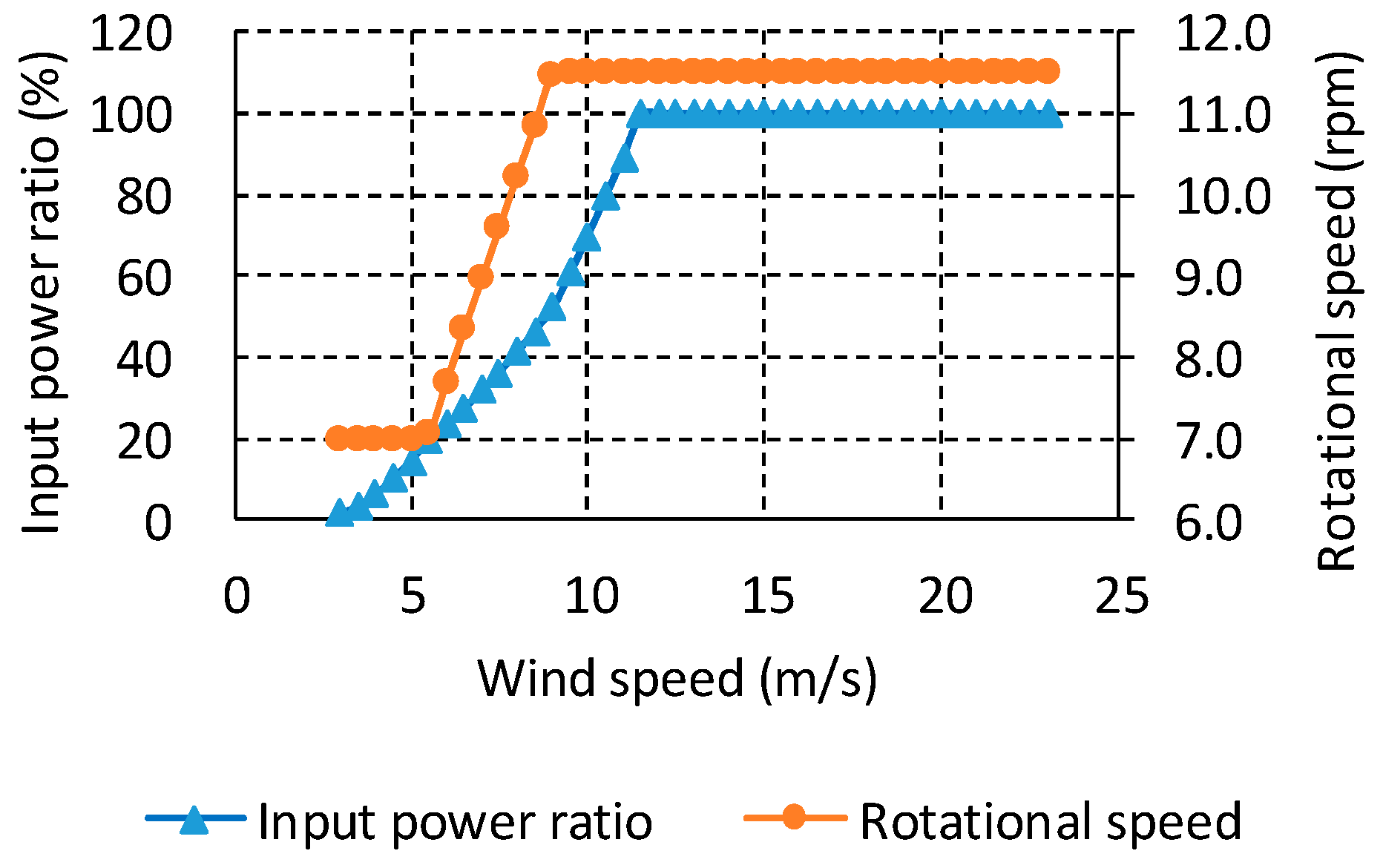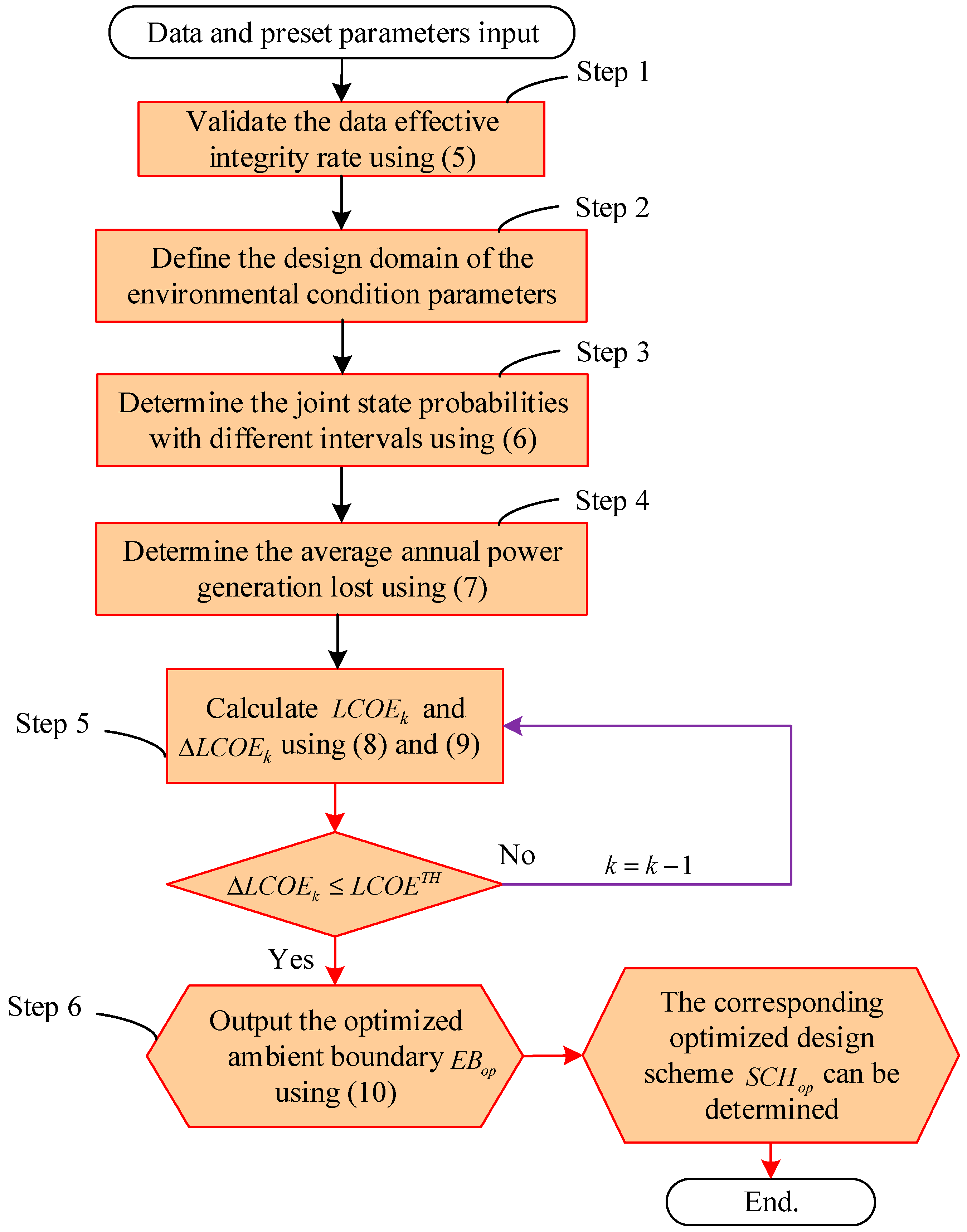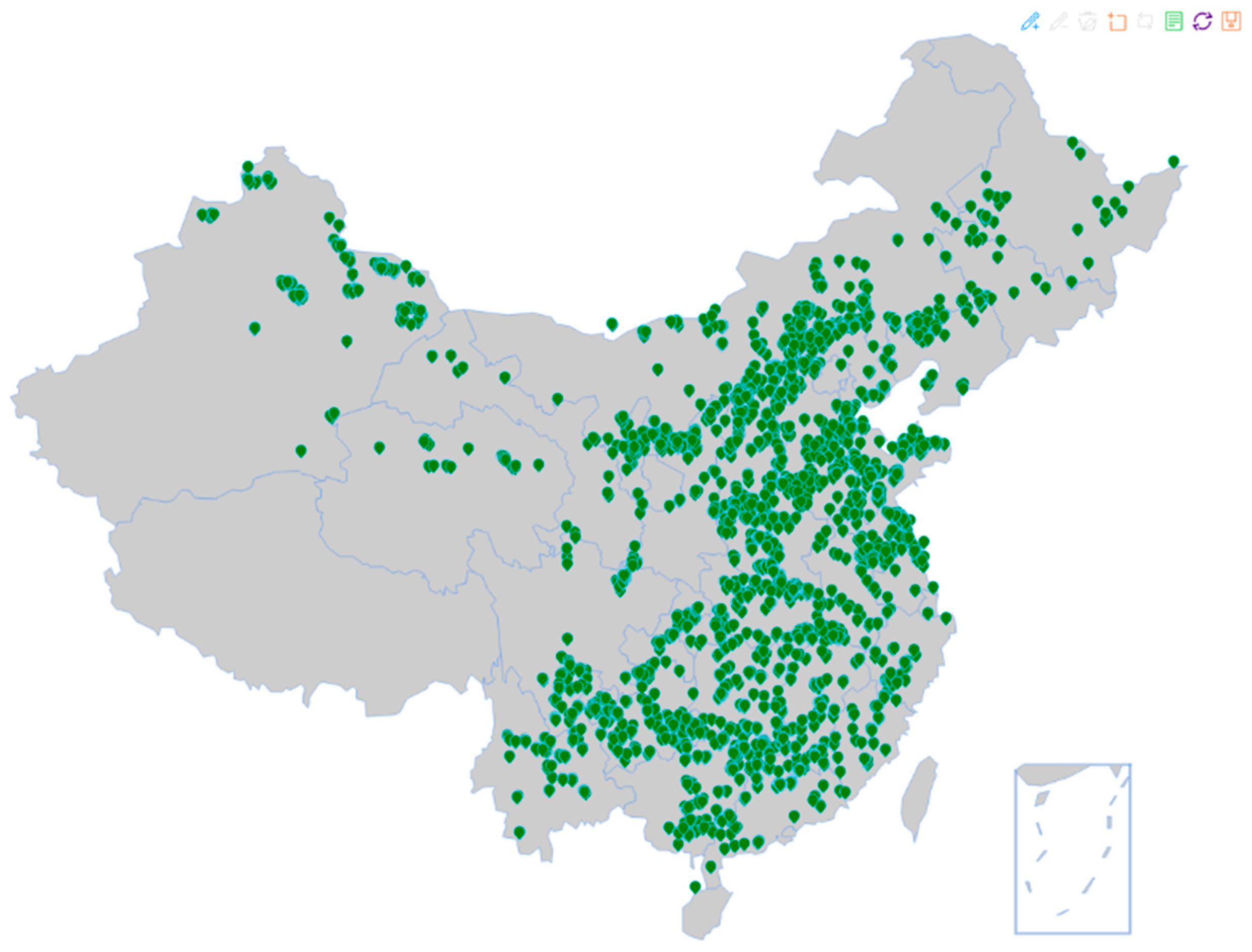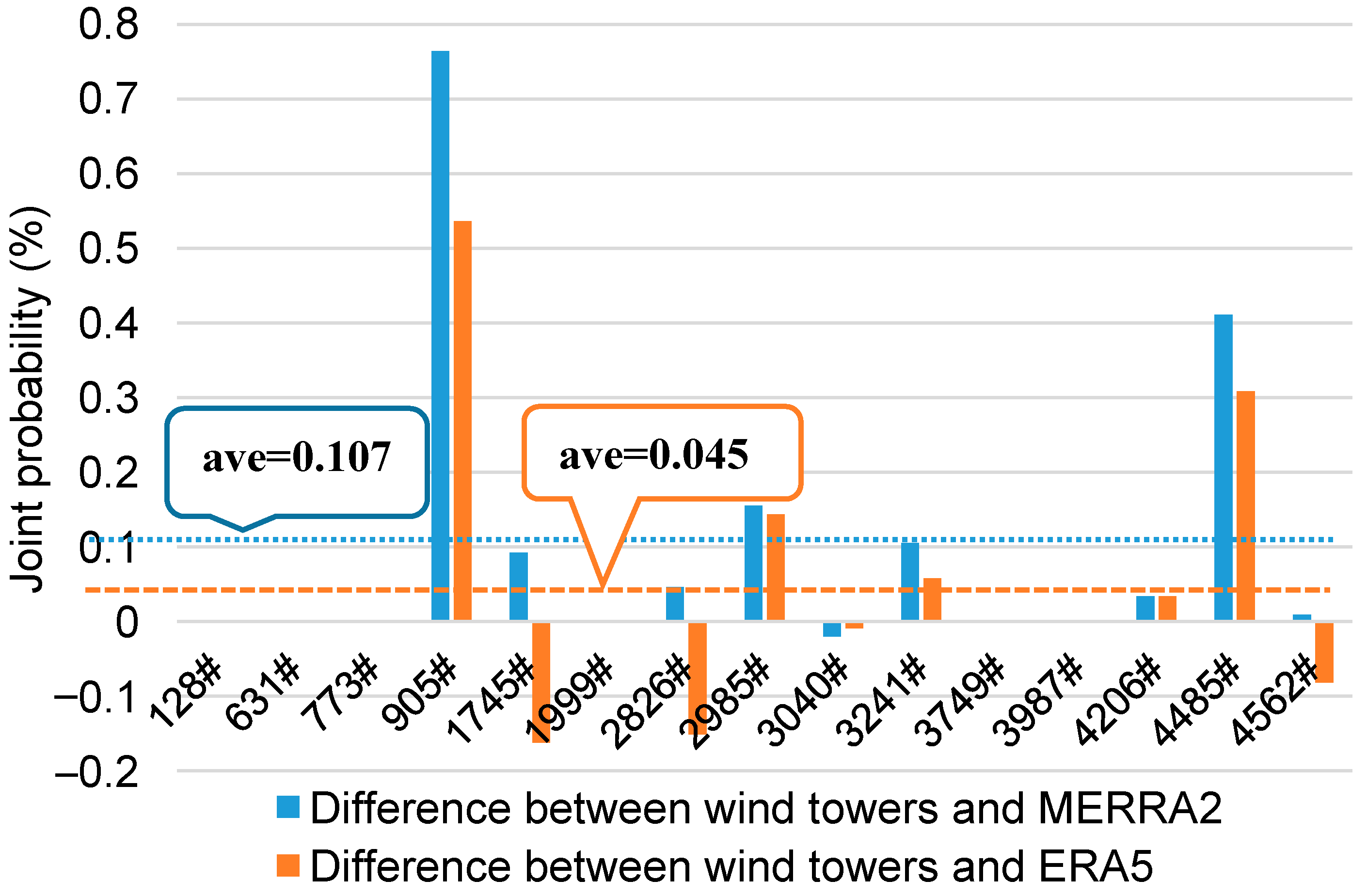Environmental Condition Boundary Design for Direct-Drive Permanent Magnet (DDPM) Wind Generators by Using Extreme Joint Probability Distribution
Abstract
:1. Introduction
- (1)
- By considering the unique characteristics of MW-level DDMPG design and operation, we analyze the key parameters of environmental conditions that affect the generator designing boundaries. These key parameters involve the wind speed, environmental temperatures, altitude, and wind duration period. The correlation mechanisms of these parameters are shown by using the upcoming joint probability distribution method. The coupled relationship between the DDPMG designing boundaries and environmental conditions can thus be revealed.
- (2)
- To select the optimal DDPMG designing scheme and perform LCOE evaluation, an extreme joint probability distribution method is designed for the environmental conditions. The 3.3.3-MW Goldwind DDPMG and datasets from five typical wind farms of China are used for experimental validation, demonstrating the joint mechanism of the key parameters and effectiveness of the proposed method on boundary optimization.
2. Analysis on the Key Parameters of Environmental Conditions
2.1. Effects of Wind Speed on Operating Characteristics of DDPMG
2.2. Effects of Ambient Temperature and Altitude on Operating Characteristics of DDPMG
2.3. Effects of Wind Duration Period on Operating Characteristics of DDPMG
- (a)
- Some key environmental conditions may have direct influence on the DDPMG operating speed, input power, operating efficiency, maximum winding temperature for safe operation, and the period of reaching stable temperature. These conditions include the wind speed, ambient temperature, altitude, and wind duration period.
- (b)
- When the wind speed varies between 3 m/s and 25 m/s, the generator rotational speed, input, and output power, as well as the operating efficiency will be located at different characteristic operating points. The component temperature can reach the maximum steady-state temperature only when the wind speed continues for a certain period of time in the rated power range.
- (c)
- According to Equations (1) and (2), to ensure that the operating temperature does not exceed the maximum allowable operating temperature of the material, although the generator can operate for a long time under different combination of ambient temperature and altitude, the ambient temperature corresponding to the altitude of 1000 m can be used as the baseline of the ambient temperature boundary conditions for safe operation.
3. Extreme Joint Probability Distribution Method of Boundary Design
3.1. Cost Model Based on LCOE
3.2. Evaluation Method and Process of the Proposed Method
- Step 1: Validate the datasets of environmental condition parameters.
- Step 2: Define the design domain of the environmental condition parameters.
- Step 3: Determine the joint state probabilities with different intervals.
- Step 4: Determine the average annual power generation loss with different intervals.
- Step 5: LCOE-based scheme selection and ambient condition boundary optimization.
- Step 6: Output the optimized ambient boundary and corresponding design scheme .
4. Case Studies of Typical Regions in China
4.1. Analysis of Environmental Conditions in Typical Land Areas of China
- (a)
- The northwest region has the maximum joint probability of 0.62% in the altitude range of [0 m, 1000 m] with the ambient temperature greater than 25 °C. The maximum joint probability of temperature is 0.0051%, which occurs in Northeast China with the ambient temperature greater than 37 °C.
- (b)
- In the altitude range of [1000 m, 1250 m], the maximum joint probability is 0.59%, which occurs in Northeast China as well, with the ambient temperature greater than 25 °C. The maximum joint probability of temperature is 0.03%, with the ambient temperature greater than 29 °C.
- (c)
- In the altitude range of [1250 m, 1500 m], the maximum joint probability is 0.102%, which occurs in Northwest China, with the ambient temperature greater than 25 °C. The maximum joint probability of temperature is 0.003%, with the ambient temperature greater than 31 °C.
- (d)
- The joint state probabilities with altitude greater than 1500 m are very small and are neglected.
- (a)
- Among the five typical regions in China, there exist joint probabilities within the wind speed range of [9 m/s, 12 m/s] and temperate range of [25 °C, 37 °C]. The maximum joint probability is 0.14%, which occurs in Northwest China, with the wind speed greater than 9 m/s and ambient temperature higher than 25 °C.
- (b)
- The maximum joint probability of temperature is 0.0004%, which occurs in Central China with the wind speed greater than 11 m/s and ambient temperature larger than 37 °C.
4.2. Design Scheme Selection and Ambient Boundary Optimization by Using LCOE Evaluation
- (a)
- (b)
- For the AEP, provides an approximately 0.18% decrease of mean cost in the wind range of 5~8 m/s, compared to , whereas higher average speed renders less decrease of cost.
- (c)
- For the turbine cost, enables a 2.98% decrease of generator cost and a 1.07% decrease of turbine cost, compared to , so a higher revenue can be gained for the same selling price of turbine.
- (d)
- For the LCOE, Table 2 shows that enables a 0.32% decrease of average LCOE in the wind range of 5~8 m/s.
5. Extended Data Resources for Supplement of Ambient Boundary Analysis
6. Conclusions
Author Contributions
Funding
Institutional Review Board Statement
Informed Consent Statement
Data Availability Statement
Conflicts of Interest
References
- Caboni, M.; Campobasso, M.; Minisci, E. Wind Turbine Design Optimization under Environmental Uncertainty. J. Eng. Gas Turbines Power Trans. ASME 2016, 138, 082601. [Google Scholar] [CrossRef]
- Simão, M.L.; Sagrilo, L.; Videiro, P. A multi-dimensional long-term joint probability model for environmental parameters. Ocean. Eng. 2022, 255, 111470. [Google Scholar] [CrossRef]
- Dong, J.; Lv, S.; Zhu, Y.; Han, H.; Zhang, G. Research on Wind Power Energy Storage Joint Optimization Operation under the Double Detailed Rules Assessment Taking into Account the Benefits of Green Certificate. Sustainability 2023, 15, 431. [Google Scholar] [CrossRef]
- Toft, H.; Svenningsen, L.; Sørensen, J.; Moser, W.; Thøgersen, M. Uncertainty in wind climate parameters and their influence on wind turbine fatigue loads. Renew. Energy 2016, 90, 352–361. [Google Scholar] [CrossRef]
- Vorpahl, F.; Schwarze, H.; Fischer, T.; Seidel, M.; Jonkman, J. Offshore wind turbine environment, loads, simulation, and design. Wiley Interdiscip. Rev. Energy Environ. 2013, 2, 548–570. [Google Scholar] [CrossRef]
- Dong, S.; Chen, C.; Tao, S. Joint probability design of marine environmental elements for wind turbines. Int. J. Hydrog. Energy 2017, 42, 18595–18601. [Google Scholar] [CrossRef]
- Mirnikjoo, S.; Abbaszadeh, K.; Abdollahi, S. Multiobjective Design Optimization of a Double-Sided Flux Switching Permanent Magnet Generator for Counter-Rotating Wind Turbine Applications. IEEE Trans. Ind. Electron. 2021, 68, 6640–6649. [Google Scholar] [CrossRef]
- Dube, L.; Garner, K.; Kamper, M. Performance of Multi Three-Phase Converter-Fed Non-Overlapping Winding Wound Rotor Synchronous Wind Generator. In Proceedings of the International Conference on Electrical Machines (ICEM), Valencia, Spain, 5–8 September 2022. [Google Scholar]
- Yuan, Z.P.; Li, P.; Li, Z.L.; Xia, J. Data-Driven Risk-Adjusted Robust Energy Management for Microgrids Integrating Demand Response Aggregator and Renewable Energies. IEEE Trans. Smart Grid 2023, 14, 365–377. [Google Scholar] [CrossRef]
- Fingersh, L.; Hand, M.; Laxson, A. Wind Turbine Design Cost and Scaling Model; Technical Report, TP-500-40566; National Renewable Energy Laboratory: Golden, CO, USA, 2006.
- Shields, M.; Beiter, P.; Jake, D.; Nunemaker, A.; Cooperman, P. Duffy, Impacts of Turbine and Plant Upsizing on the Levelized Cost of Energy for Offshore Wind. Appl. Energy 2021, 298, 117189. [Google Scholar] [CrossRef]
- Chen, J.; Wang, F.; Stelson, K. A mathematical approach to minimizing the cost of energy for large utility wind turbines. Appl. Energy 2018, 228, 1413–1422. [Google Scholar] [CrossRef]
- IEC 60034-29; Rotating Electrical Machines-Part 29: Equivalent Loading and Superposition Techniques—Indirect Testing to Determine Temperature Rise. IEC: Geneva, Switzerland, 2008.
- IEC 60034-1; Rotating Electrical Machines-Part 1: Rating and Performance. IEC: Geneva, Switzerland, 2017.
- Hasager, C.; Badger, M.; Nawri, N. Mapping Offshore Winds Around Iceland Using Satellite Synthetic Aperture Radar and Mesoscale Model Simulations. IEEE J. Sel. Top. Appl. Earth Obs. Remote Sens. 2015, 8, 5541–5552. [Google Scholar] [CrossRef] [Green Version]
- Castorrini, A.; Gentile, S.; Geraldi, E.; Bonfiglioli, A. Investigations on offshore wind turbine inflow modelling using numerical weather prediction coupled with local-scale computational fluid dynamics. Renew. Sustain. Energy Rev. 2023, 171, 113008. [Google Scholar] [CrossRef]










| Parameters | ||
|---|---|---|
| Cost of generator (Yuan) | −2.98 | |
| Cost of turbine (Yuan/kW) | −1.07 | |
| Generator efficiency (%) | Rated power point | −0.78 |
| 50% rated power point | −0.2 | |
| AEP for 5~8 m/s wind speed (kW/h) | −0.22~0.15 | |
| LCOE for 5~8 m/s wind speed (Yuan/kW/h) | −0.28~0.35 | |
| Annual Average Wind Speed (m/s) | AEP (%) | LCOE (%) |
|---|---|---|
| 5 | −0.17 | −0.29 |
| 5.5 | −0.19 | −0.31 |
| 6 | −0.20 | −0.31 |
| 6.5 | −0.21 | −0.29 |
| 7 | −0.19 | −0.36 |
| 7.5 | −0.15 | −0.35 |
| 8 | −0.16 | −0.34 |
| Average value | −0.18 | −0.32 |
| Dataset | Source | Time Range | Interval | Variable | Spatial Resolution | Height Layer |
|---|---|---|---|---|---|---|
| ERA5 | ECWMF | 1979-now | 1 h | Wind, temperature, pressure | 0.25° × 0.25° | 100 m/10 m |
| MERRA2 | NASA | 1980-now | 1 h | Wind, temperature, pressure | 0.625° × 0.5° | 50 m/10 m |
| ERA_Interim | ECWMF | 1979-now | 6 h | Wind, temperature, pressure humidity, precipitation | 0.75° × 0.75° | multiple |
| JRA55 | JRA | 1962-now | 6 h | Wind, temperature, pressure humidity, precipitation | 0.56° × 0.56° | multiple |
| Region | Number of Wind Towers | Minimum Difference (%) | Maximum Difference (%) | ||
|---|---|---|---|---|---|
| North China | 269 | 21 | −0.776 | 0.372 | 5 |
| Central China | 79 | 25 | −0.489 | 0.424 | 0 |
| Northeast China | 70 | 11 | −0.536 | 0.137 | 1 |
| East China | 120 | 22 | −0.333 | 0.241 | 0 |
| Northwest China | 68 | 12 | −0.501 | 0.187 | 1 |
| Total | 606 | 91 | -- | -- | 7 |
Disclaimer/Publisher’s Note: The statements, opinions and data contained in all publications are solely those of the individual author(s) and contributor(s) and not of MDPI and/or the editor(s). MDPI and/or the editor(s) disclaim responsibility for any injury to people or property resulting from any ideas, methods, instructions or products referred to in the content. |
© 2023 by the authors. Licensee MDPI, Basel, Switzerland. This article is an open access article distributed under the terms and conditions of the Creative Commons Attribution (CC BY) license (https://creativecommons.org/licenses/by/4.0/).
Share and Cite
Tian, D.; Xia, J.; Liu, X.; Hao, J.; Li, Y.; Li, P. Environmental Condition Boundary Design for Direct-Drive Permanent Magnet (DDPM) Wind Generators by Using Extreme Joint Probability Distribution. Sustainability 2023, 15, 4220. https://doi.org/10.3390/su15054220
Tian D, Xia J, Liu X, Hao J, Li Y, Li P. Environmental Condition Boundary Design for Direct-Drive Permanent Magnet (DDPM) Wind Generators by Using Extreme Joint Probability Distribution. Sustainability. 2023; 15(5):4220. https://doi.org/10.3390/su15054220
Chicago/Turabian StyleTian, De, Jing Xia, Xiaoya Liu, Jingjing Hao, Yan Li, and Peng Li. 2023. "Environmental Condition Boundary Design for Direct-Drive Permanent Magnet (DDPM) Wind Generators by Using Extreme Joint Probability Distribution" Sustainability 15, no. 5: 4220. https://doi.org/10.3390/su15054220





